Lower Yields Reduce Corn Crop, Still Second Largest Ever
Because of slightly lower corn yields, US corn production is forecast at 12.921 billion bushels this month. This is still the second largest crop behind the 13.038 billion bushels produced in 2007. Fractional changes are made in sorghum, barley, and oats because of late harvests. Most of the grain use categories are unchanged this month, except that US exports are lowered for corn and barley. Increased competition from Ukrainian corn and from feed-quality wheat from the Black Sea is contributing to a slowdown in US exports and sales. Additional factors affecting US corn export prospects include the flow of exports from South America, the slow pace of the US corn harvest, concerns about US corn quality, and increases in US corn prices, partly influenced by funds investing in commodities as a hedge against inflation.
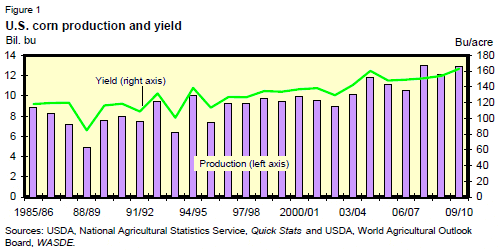
Feed Grain Production Prospects Lowered in 2009/10
US feed grain production for 2009/10 is forecast at 343.7 million metric tons, down from 346.2 million last month but up from 325.9 million in 2008/09. The month-to-month decrease came from lower forecast corn production; barley, sorghum, and oats are essentially unchanged this month. There were no changes in beginning stocks or imports; therefore, total supply is decreased the same amount as production.
Total 2009/10 feed grain utilisation is projected at 347.2 million tons, down from 348.6 million last month but up from 326.8 million in 2008/09. Feed and residual use and food, seed, and industrial (FSI) use remain unchanged this month. Exports are lowered this month to 57.2 million tons from 58.5 million, but up from 51.2 million in 2008/09 as a result of lowered corn and barley exports. Forecast feed grain ending stocks are decreased this month to 46.1 million tons, down from 47.2 million last month. Price prospects for all feed grains are up this month for 2009/10.
Minor changes were made for the 2008/09 marketing year for feed grains as a result of final ethanol production numbers, which lowered corn FSI use but raised corn feed and residual use. Total feed grain feed and residual use increased 600,000 tons, to 142.7 million for 2008/09.
On a September-August marketing year basis, feed and residual use for the four feed grains plus wheat in 2009/10 is projected to total 149.4 million metric tons, up from 145.5 million a year earlier. Corn is estimated to account for 92 per cent of the total, unchanged from 2008/09. The projected index of grain-consuming animal units (GCAU) in 2009/10 is 91.76 million, down from 92.81 million in 2008/09. Feed and residual use per GCAU is estimated at 1.63 tons, up from 1.57 tons in 2008/09. Normally, when yields are above trend, feed and residual use is higher, even when livestock numbers and meat production are down.
Cattle on feed are up 300,000 head this month as fourth quarter 2009 beef production is forecast higher due to larger feedlot placements in 2009. However, meat production for 2010 is lowered this month as higher forecast beef production is more than offset by lower forecasts for broilers and turkeys. Milk production is forecast higher for 2009 and 2010 as milk per cow is forecast higher and the rate of decline in cow inventories is slowed.
Minor Changes Made to 2008/09 Marketing Year
Corn FSI use is lowered 23 million bushels this month, as corn used for ethanol is lowered by the same amount. This change is based on ethanol production data from the US Energy Information Administration. As a result, feed and residual use is raised 23 million bushels to 5,254 million bushels for 2008/09.
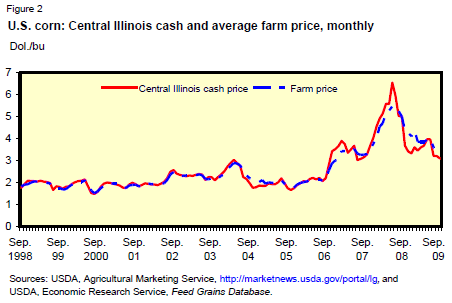
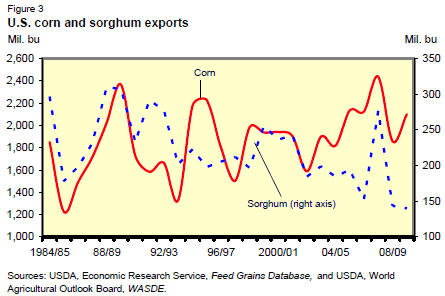
2009/10 Corn Crop Forecast Lowered
US corn production is forecast at 12.921 billion bushels, down 97 million from last month. Based on conditions as of November 1, yields are expected to average 162.9 bushels per acre, down 1.3 bushels from last month but 9.0 bushels above last year.
Despite the drop from October, this yield, if realised, would be the highest on record. Total production will be the second highest on record, only behind 2007. Beginning stocks and imports are unchanged this month, resulting in projected total supply of 14.605 billion bushels, down from last month’s 14.702 billion.
The 1 November corn objective yield data indicate a record number of ears per acre for the combined 10 objective yield States (Illinois, Indiana, Iowa, Kansas, Minnesota, Missouri, Nebraska, Ohio, South Dakota, and Wisconsin). All objective yield States, except Missouri, recorded record-high ear counts.
Crop maturity continued to lag behind the normal pace in October due to both late spring planting and below average temperatures. The harvest pace was 1 month behind the 5-year average. Harvest delays of 3 weeks or more were evident in the 6 largest corn-producing States. Across the Plains, Midwest, and South, near-record to record-setting wetness contributed to the sluggish harvest pace and declines in the quality of the crops remaining in the field. Conditions in unharvested corn fields throughout the Great Plains, Corn Belt, and Great Lakes continued to deteriorate as reports of unfavorably high moisture levels and mold were reported.
Total corn use for 2009/10 is decreased from last month as projected exports are lowered 50 million bushels to 2.100 billion bushels. This decrease is a result of the slow pace of sales and shipments to-date, increased competition from foreign sources, and higher global wheat feeding. Lower exports and production decrease projected ending stocks to 1.625 billion bushels, down 47 million from last month. Lower projected ending stocks and strength in futures prices raise prospects for 2009/10 prices received by farmers. The projected season average prices are raised 20 cents on both ends of the range to $3.25 to $3.85 per bushel, compared with $4.06 in 2008/09.
Sorghum Price Prospects Raised in 2009/10
Sorghum production increased slightly this month, raising total supply up 1 million bushels from last month to 419 million for 2009/10. This increase resulted in a 1-million-bushel increase in ending stocks to 49 million bushels. Reflecting a higher expected corn price and strong marketings to date, the projected price range for sorghum is raised to $2.85 to $3.45 per bushel, up 25 cents on both ends of the range, compared with $3.20 per bushel in 2008/09.
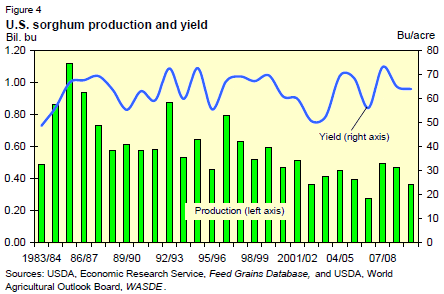
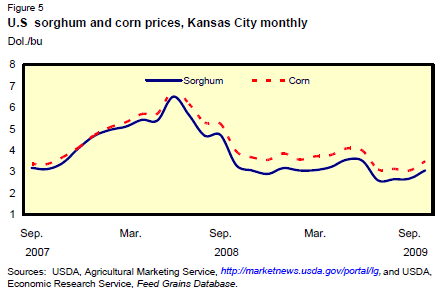
Barley and Oats Prices Raised
Barley yield is estimated at 73.0 bushels per acre, up 0.2 bushels per acre this month; however, barley production for 2009/10 remains unchanged at an estimated 227 million bushels because area harvested is lowered. Barley exports for 2009/10 are projected 5 million bushels lower to 10 million, as a result of the slow pace of exports to date. This lowers total use 5 million bushels to 230 million. As a result, ending stocks are forecast at 116 million bushels, up 5 million. The projected price range is raised 40 cents on both ends of the range to $4.10 to $4.60 per bushel, compared to $5.37 per bushel last year.
Oats yield is estimated 0.1 bushels per acre lower to 67.5 bushels this month. Oats production for 2009/10 remains nearly unchanged at 93 million bushels, as the small increase in yield adds only 195,000 bushels to production. The projected price range is raised to $2.00 to $2.30 per bushel, up 15 cents on both end of the range, compared with $3.15 per bushel last year.
Competition Reduces US Corn Export Prospects for 2009/10
Increased competition from Ukrainian corn and from feed-quality wheat from the Black Sea (mostly Ukraine, Russia, and parts of the EU) is contributing to a slowdown in US exports and sales. Additional factors contributing to the dropoff include the flow of exports from South America, the slow pace of the US corn harvest, concerns about US corn quality, and increases in US corn prices, partly influenced by funds investing in commodities as a hedge against inflation. US exports projected for the 2009/10 October-September trade year are reduced 1.5 million tons this month to 53.0 million. The local marketing year export forecast is cut 50 million bushels to 2.1 billion. Although the marketing year started with large outstanding export sales, and September 2009 Census corn exports of 4.9 million tons was a strong start, the export pace slowed dramatically in October, with corn export inspections reported at less than 3.0 million tons. Net export sales reported during the 5 weeks of October 2009 were only 2.3 million tons, down from 3.6 million a year earlier.
Ukraine’s 1.0-million-ton production increase and the rapid early pace of corn exports from Ukraine support the country’s 1.0-million-ton increase in projected exports to 4.0 million. While projected corn exports for Argentina and Brazil are not increased this month, their governments moved to facilitate corn exports, with Argentina expanding export registration quotas and Brazil releasing funding that subsidizes the movement of government-owned stocks to export positions. Israel’s projected corn imports are cut 0.3 million tons this month to 1.0 million, and an offsetting increase is made for wheat imports, as feed-quality wheat prices are more attractive than corn prices. The reduction in corn imports for Israel is partly offset by an increase for Venezuela, up 0.2 million tons to 1.3 million due to production problems.

In barley trade, US October-September exports are reduced 0.1 million tons to 0.2 million. EU barley exports for 2009/10 projected 0.2 million tons lower to 2.3 million, and Jordan’s imports are trimmed by the same amount to 0.5 million. There are no significant changes this month for 2009/10 sorghum and oats trade, but for rye, exports by Belarus and imports for Japan are reduced.
Increased Foreign Coarse Grain Production Partly Offsets US Drop
World coarse grain production in 2009/10 is projected at 1,091.6 million tons, down 0.9 million this month. However, foreign production is forecast to reach 747.7 million tons, up 1.6 million, partly offsetting the US decline. Foreign corn production is projected down slightly, 0.3 million tons, to 461.5 million, as several significant changes are offsetting. Foreign barley production is up 0.6 million tons to 142.9 million, foreign sorghum is increased slightly to 54.7 million tons, millet is unchanged this month at 32.8 million tons, foreign oats are up 0.3 million tons to 22.9 million, foreign rye is up fractionally to 16.8 million tons, and mixed grains are up 1.0 million tons to 16.1 million.
Corn production for two leading exporting countries is increased significantly this month. Ukraine’s corn production is up 1.0 million tons to 10 million, based on harvest reports indicating better-than-expected yields. South Africa, still planting, is projected to produce 11.5 million tons of corn, also up 1.0 million this month.
Despite concerns about potential drought associated with an ongoing El Nino weather pattern in the Pacific, producers are being encouraged by excellent rains during planting to expand area planted.


These increases are more than offset by several countries with reduced corn production this month. In Brazil, corn production is reduced 1.0 million tons to 51.0 million due to a reduction in expected area. The relative prices make soybeans more attractive than corn, with first-crop corn area in Southern Brazil shifting to soybeans.
EU corn production is reduced 0.4 million tons to 56.1 million based on countries’ official production estimates as harvest winds down. Reductions for Germany, France, the Czech Republic, Austria, and Hungary more than offset increases for Italy and Spain.
Russia’s corn production prospects are cut 0.3 million tons to 4.4 million, based on lower area harvested for grain. Summer dryness and hot temperatures in Russia’s Southern District hurt corn production. Venezuela’s corn production is also cut 0.3 million tons to 1.8 million this month due to winter drought in the main crop area of Guarico.
Canada’s corn production is trimmed 0.2 million tons to 9.5 million, as delayed development, frost, and harvest delays combine to trim yield prospects in Ontario. There are also small reductions in corn production this month for Belarus and South Korea.
EU barley production increased 0.5 million tons to 61.9 million as improved yields were reported in Spain, France, and Germany, more than offsetting a reduction in Slovakia. Barley production in Kazakhstan increased 0.4 million tons to 2.1 million as exceptionally favorable extended harvest boosted area and yield. There was also a small increase in barley production for Chile and reductions for Mexico (with several years of revisions for barley and oats), Syria, and Croatia.
EU sorghum is boosted slightly, mostly due to higher reported production in France, but this increase was partly offset by slightly reduced sorghum prospects in Venezuela. The EU also accounted for most of the increases for foreign oats, rye, and mixed grain. Poland reported a modest increase in oats production and a dramatic 1.0-million-ton increase in triticale, included in USDA’s mixed grains.
Reduced Foreign Beginning Stocks Trim 2009/10 Supply
Foreign coarse grain beginning stocks are revised down 1.1 million tons this month to 142.4 million tons. EU 2009/10 coarse grain beginning stocks are down 1.2 million tons this month, mostly due to increased corn feed use estimated for 2008/09. Increased 2008/09 food, seed, and industrial (FSI) use of corn for South Africa reduces 2009/10 beginning stocks by 0.8 million tons. There are smaller reductions in coarse grain beginning stocks for Uruguay, South Korea, Algeria, Thailand, Mexico, Japan, and Switzerland. Changes to 2008/09 supply and demand were made for many countries as trade data became more complete. For several countries, increased 2008/09 imports tended to boost 2009/10 beginning stocks. Coarse grain beginning stocks increased 0.2 million tons this month for Egypt, Venezuela, Brazil, Paraguay, Vietnam, and China, with smaller increases for India, Croatia, and others.
Reduced global beginning stocks and lower projected production combine to reduce world coarse grain supply for 2009/10 by 2.0 million tons to 1,281.1 million.
Changes to Projected 2009/10 Coarse Grain Use Mostly Offsetting
Global coarse grain use in 2009/10 is projected up fractionally this month to 1,103.8 million tons. Revised projections for several countries are mostly offsetting. EU coarse grain use is up 1.0 million tons this month to 152.9 million tons, with the increase nearly evenly divided between FSI use and feed and residual use. Increases for mixed grains, oats, corn, rye, and sorghum were partly offset by a 0.5-million-ton cut in projected barley feed use.
South Africa’s coarse grain use is up 0.4 million tons this month, with an increase in corn FSI use more than offsetting a 0.2-million-ton decline in feed use. These projections are in line with revisions to the previous 2 years of corn use estimates.
Israel’s corn feed use is cut 0.3 million tons this month as a shift to feed quality wheat is projected. There is a 0.2 million ton increase for Egypt and a 0.2-millionton decline for Russia, with smaller changes for 12 other countries.
Global Coarse Grain Ending Stocks Projected Lower This Month
World coarse grain stocks are reduced 2.3 million tons to 177.3 million tons, with nearly half the reduction in US stocks. World corn stocks are forecast down 3.8 million tons to 132.4 million, but increased barley, mixed grain, and oats stocks are partly offsetting. Global rye and sorghum stocks are projected down slightly this month.
Brazil’s coarse grain stocks are reduced 0.8 million tons to 9.8 million due to reduced corn production prospects. EU stocks are projected down 0.6 million tons as increased production is offset by reduced beginning stocks, leaving supplies little changed, but increased forecast use lowers ending stocks. Coarse grain stocks in Kazakhstan are forecast up 0.4 million tons due to increased barley production. There are smaller changes for 20 countries.
Further Reading
| - | You can view the full report by clicking here. |
November 2009


